Monthly Updates on Recent Books in the History of Christianity
Due to the cancellation of many conferences in the past six months amid the COVID-19 pandemic, many of us have had less opportunity to browse or even see new books coming out in our fields. To raise awareness of recent books in the history of Christianity, the editorial staff of Church History: Studies in Christianity and Culture will be highlighting each month a list of 10-15 books in diverse periods and geographical regions that we hope will be of interest to our members. We include here below the first monthly list, chosen by our staff, with excerpts from the publishers’ blurbs. These books will also be featured on our social media accounts in groups of two or three per week.

Dennis Dickerson, The African Methodist Episcopal Church: A History. 2020
In this book, Dennis C. Dickerson examines the long history of the African Methodist Episcopal Church and its intersection with major social movements over more than two centuries. Beginning as a religious movement in the late eighteenth century, the African Methodist Episcopal Church developed as a freedom advocate for blacks in the Atlantic World. Governance of a proud black ecclesia often clashed with its commitment to and resources for fighting slavery, segregation, and colonialism, thus limiting the full realization of the church's emancipationist ethos. Dickerson recounts how this black institution nonetheless weathered the inexorable demands produced by the Civil War, two world wars, the civil rights movement, African decolonization, and women's empowerment, resulting in its global prominence in the contemporary world. His book also integrates the history of African Methodism within the broader historical landscape of American and African-American history.
See publisher's website here.

Sara Georgini, Household Gods: The Religious Lives of the Adams Family. 2019
Reflecting on his past, President John Adams mused that it was religion that had shaped his family's fortunes and young America's future. For the nineteenth century's first family, the Adamses of Massachusetts, the history of how they lived religion was dynamic and well-documented. Christianity supplied the language that Abigail used to interpret husband John's political setbacks. Scripture armed their son John Quincy to act as father, statesman, and antislavery advocate. Unitarianism gave Abigail's Victorian grandson, Charles Francis, the religious confidence to persevere in political battles on the Civil War homefront. By contrast, his son Henry found religion hollow and repellent compared to the purity of modern science. A renewal of faith led Abigail's great-grandson Brooks, a Gilded Age critic of capitalism, to prophesy two world wars.
Globetrotters who chronicled their religious journeys extensively, the Adamses ultimately developed a cosmopolitan Christianity that blended discovery and criticism, faith and doubt. Drawing from their rich archive, Sara Georgini, series editor for The Papers of John Adams, demonstrates how pivotal Christianity--as the different generations understood it--was in shaping the family's decisions, great and small. Spanning three centuries of faith from Puritan New England to the Jazz Age, Household Gods tells a new story of American religion, as the Adams family lived it.
See publisher's website here.
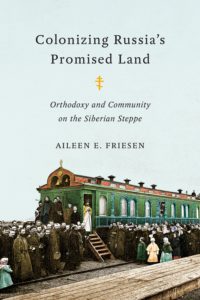
Aileen E. Friesen, Colonizing Russia’s Promised Land: Orthodoxy and Community on the Siberian Steppe. 2020
The movement of millions of settlers to Siberia in the late nineteenth and early twentieth centuries marked one of the most ambitious undertakings pursued by the tsarist state. Colonizing Russia’s Promised Land examines how Russian Orthodoxy acted as a basic building block for constructing Russian settler communities in current-day southern Siberia and northern Kazakhstan. Russian state officials aspired to lay claim to land that was politically under their authority, but remained culturally unfamiliar. By exploring the formation and evolution of Omsk diocese – a settlement mission – Colonizing Russia’s Promised Land reveals how the migration of settlers expanded the role of Orthodoxy as a cultural force in transforming Russia’s imperial periphery by "russifying" the land and marginalizing the Indigenous Kazakh population.
In the first study exploring the role of Orthodoxy in settler colonialism, Aileen Friesen shows how settlers, clergymen, and state officials viewed the recreation of Orthodox parish life as practiced in European Russia as fundamental to the establishment of settler communities, and to the success of colonization. Friesen uniquely gives peasant settlers a voice in this discussion, as they expressed their religious aspirations and fears to priests and tsarist officials. Despite this agreement, tensions existed not only among settlers, but also within the Orthodox Church as these groups struggled to define what constituted the Russian Orthodox faith and culture.
See publisher's website here.
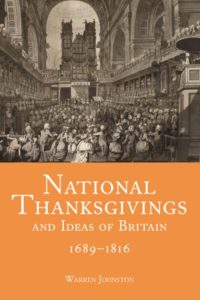
Warren Johnston, National Thanksgivings and Ideas of Britain, 1689-1816. 2020
This book is the first concentrated study of almost 600 sermons from over forty national thanksgivings in Britain during the long eighteenth century. These included celebrations of the 'Glorious' Revolution, the Union of England and Scotland, the Hanoverian succession, and the numerous military successes stretching from the reigns of William and Mary and Queen Anne to the Battle of Waterloo. Preachers used such occasions to reinforce ideas associated with Britain and being British during a significant period of national growth. Although the thanksgiving ceremonies were instigated through royal order, and accompanied by prescribed liturgies, the composition and delivery of sermons by clergymen in thousands of churches resulted in numerous and diverse expressions on developments within British society across a period of over 125 years. The sermons were written by ministers from across England, as well as some from Scotland, Ireland, Wales, and colonial North America. In addition to those from Anglican pulpits, many of the sermons were by dissenting ministers. Overall, the book presents a vast array of information from a wide range of viewpoints, demonstrating how prominent national commemorations were used by preachers to convey compelling ideas about Britain and Britons from 1689 to 1816.
See publisher's website here.
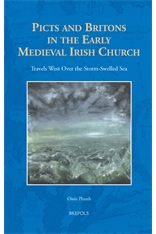
O. Plumb, Picts and Britons in the Early Medieval Irish Church: Travels West over the Storm-Swelled Sea. 2020
A study of the lives and legacy of Picts and Britons in the Irish Church, looking at their impact on early medieval Irish society and how this impact came to be perceived in later centuries.
Between the fifth and ninth centuries AD, the peoples of Britain, Ireland, and their surrounding islands were constantly interacting. The influence of religious figures from Ireland on the development of the Church in Britain was profound. Yet with the exception of St Patrick, far less attention has been paid to the role of the Britons and Picts who travelled west into Ireland, despite their equally significant impact.
This book aims to redress the balance by offering a detailed exploration of the evidence for British and Pictish men and women in the early medieval Irish Church, and asking what we can piece together of their lives from the often fragmentary sources. It also considers the ways in which writers of later ages viewed these migrants, and examines how the shaping of the ‘migration narrative’ throughout the centuries had a major effect on the way that the earliest centuries of the church came to be viewed in later years in both Scotland and Ireland. In doing so, this volume offers important new insights into our understanding of the relationships between Britain and Ireland in this period.
See publisher's website here.

Jonathan Warren Pagán, Giles Firmin and the Transatlantic Puritan Tradition: Polity, Piety, and Polemic. 2020
In Giles Firmin and the Transatlantic Puritan Tradition, Jonathan Warren Pagán offers an intellectual biography of Giles Firmin (1613/14–1697), who lived in both Old and New England and lived through many of the transitions of international puritanism in the seventeenth century. By contextualizing Firmin in his intellectual milieu, Warren Pagán also offers a unique vantage on the transition of puritanism to Dissent in late Stuart England, surveying changing approaches to ecclesiology, pastoral theology, and the ordo salutis among the godly during the Restoration through Firmin’s writings.
See publisher's website here.
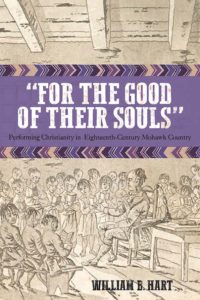
William Hart, "For the Good of Their Souls": Performing Christianity in Eighteenth-Century Mohawk Country. 2020
University of Massachusetts Press
In 1712, the Society for the Propagation of the Gospel in Foreign Parts opened its mission near present-day Albany, New York, and began baptizing residents of the nearby Mohawk village Tiononderoge, the easternmost nation of the Haudenosaunee (Iroquois) Confederacy. Within three years, about one-fifth of the Mohawks in the area began attending services. They even adapted versions of the service for use in private spaces, which potentially opened a door to an imagined faith community with the Protestants.
Using the lens of performance theory to explain the ways in which the Mohawks considered converting and participating in Christian rituals, historian William B. Hart contends that Mohawks who prayed, sang hymns, submitted to baptism, took communion, and acquired literacy did so to protect their nation’s sovereignty, fulfill their responsibility of reciprocity, serve their communities, and reinvent themselves. Performing Christianity was a means of “survivance,” a strategy for sustaining Mohawk life and culture on their terms in a changing world.
See publisher's website here.
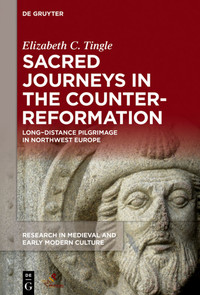
Elizabeth Caroline Tingle, Sacred Journeys in the Counter-Reformation: Long-Distance Pilgrimage in Northwest Europe. 2020
Medieval Institute Publications
Sacred Journeys in the Counter-Reformation examines long-distance pilgrimages to ancient, international shrines in northwestern Europe in the two centuries after Luther. In this region in the sixteenth and seventeenth centuries, saints' cults and pilgrimage were frequently contested, more so than in the Mediterranean world. France, the Low Countries and the British Isles were places of disputation and hostility between Protestant and Catholic; sacred landscapes and journeys came under attack and in some regions, were outlawed by the state. Taking as case studies hugely popular medieval shrines such as Compostela, Rocamadour, the Mont Saint-Michel and Lough Derg, the impact of Protestant criticism and Catholic revival on shrines, pilgrims’ motives and experiences is examined through life writings, devotional works and institutional records. The central focus is that of agency in religious change: what drove spiritual reform and what were its consequences for the ‘ordinary’ Catholic? This is explored through concepts of the religious self, holy materiality, and sacred space.
See publisher's website here.
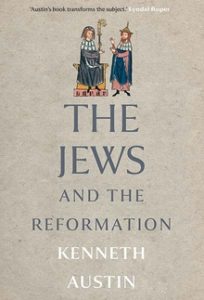
Kenneth Austin, The Jews and the Reformation. 2020
In this rich, wide-ranging, and meticulously researched account, Kenneth Austin examines the attitudes of various Christian groups in the Protestant and Catholic Reformations towards Jews, the Hebrew language, and Jewish learning. Martin Luther’s writings are notorious, but Reformation attitudes were much more varied and nuanced than these might lead us to believe. This book has much to tell us about the Reformation and its priorities—and has important implications for how we think about religious pluralism more broadly.
See publisher's website here.

Dana Robinson, Food, Virtue, and the Shaping of Early Christianity. 2020
In this book, Dana Robinson examines the role that food played in the Christianization of daily life in the fourth century CE. Early Christians used the food culture of the Hellenized Mediterranean world to create and debate compelling models of Christian virtue, and to project Christian ideology onto common domestic practices. Combining theoretical approaches from cognitive linguistics and space/place theory, Robinson shows how metaphors for piety, such as health, fruit, and sacrifice, relied on food-related domains of common knowledge (medicine, agriculture, votive ritual), which in turn generated sophisticated and accessible models of lay discipline and moral formation. She also demonstrates that Christian places and landscapes of piety were socially constructed through meals and food production networks that extended far beyond the Eucharist. Food culture, thus, provided a network of metaphorical concepts and spatial practices that allowed the lay faithful to participate in important debates over Christian living and community formation.
See publisher's website here.
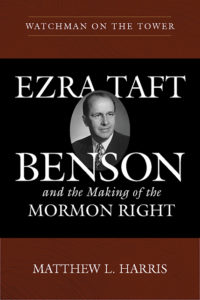
Matthew L. Harris, Watchman on the Tower: Ezra Taft Benson and the Making of the Mormon Right. 2020
Ezra Taft Benson is perhaps the most controversial apostle-president in the history of the Church of Jesus Christ of Latter-day Saints. For nearly fifty years he delivered impassioned sermons in Utah and elsewhere, mixing religion with ultraconservative right-wing political views and conspiracy theories. His teachings inspired Mormon extremists to stockpile weapons, predict the end of the world, and commit acts of violence against their government. The First Presidency rebuked him, his fellow apostles wanted him disciplined, and grassroots Mormons called for his removal from the Quorum of the Twelve. Yet Benson was beloved by millions of Latter-day Saints, who praised him for his stances against communism, socialism, and the welfare state, and admired his service as secretary of agriculture under President Dwight D. Eisenhower. Using previously restricted documents from archives across the United States, Matthew L. Harris breaks new ground as the first to evaluate why Benson embraced a radical form of conservatism, and how under his leadership Mormons became the most reliable supporters of the Republican Party of any religious group in America.
See publisher's website here.
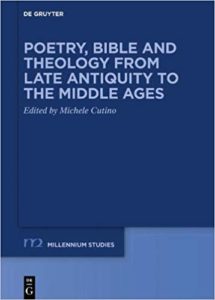
Michele Cutino, ed., Poetry, Bible and Theology from Late Antiquity to the Middle Ages. 2020
De Gruyter
This volume examines for the first time the most important methodological issues concerning Christian poetry – i.e. biblical and theological poetry in classical meters – from a diachronic perspective. Thus, it is possible to evaluate the doctrinal significance of these compositions and the role that they play in the development of Christian theological ideas and biblical exegesis.
See listing on Amazon here.
Finally, for staying up-to-date on the latest titles in all fields, we recommend regularly perusing New Books Network, and will regularly link to its “New Books in Christian Studies” page here. These pages are updated regularly.
